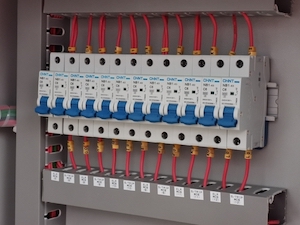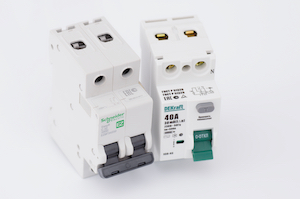How To Identify Circuit Breaker Type

Figure 1: Label on a circuit breaker showing the voltage, current ratings, and trip curve characteristics
A circuit breaker protects electrical devices from power surges and other electrical faults. Knowing the type of circuit breaker installed in the electrical system is important for several reasons, including maintenance, repair, and replacement. This article explores the various steps involved in identifying a circuit breaker type.
Table of contents
- Check the circuit breaker box label
- Identify the circuit breaker type
- Consult the manufacturer's website or documentation
- Mounting types
- FAQs
View our online selection of circuit breakers!
Check the circuit breaker box label
Read our article on circuit breakers to learn more about the construction, working, and types of circuit breakers.
The first step in identifying the circuit breaker type is to check the circuit breaker panel. The panel is usually in the basement, utility room, or garage. Open the panel door and look for labels or markings indicating the circuit breaker type installed.
- The manufacturer's label will provide information on the model number, amperage, voltage rating, and other specifications (Figure 1). Use this information to find the type of circuit breaker.
- If the label is not visible or the information is unclear, use a multimeter to measure the voltage and amperage of the circuit breaker. Set the multimeter to measure AC voltage or current (depending on what is being measured) and place the leads on either side of the breaker. The reading on the multimeter will indicate the voltage or amperage of the circuit.
Check out our article on reading circuit breakers for more information on decoding the labels on circuit breakers.
Identify the circuit breaker type

Figure 2: Double-pole breaker (left) and single-pole breaker (right)
There are three major types of circuit breakers: standard, ground fault circuit interrupters (GFCIs), and arc fault circuit interrupters (AFCIs).
Standard circuit breakers
Standard circuit breakers are simple circuit breakers that trip when a circuit overloads. They are commonly used in residential and commercial electrical systems. They can be single-pole or double-pole.
- In residential homes, the 1-inch breakers usually used are single-pole breakers that take up one slot on the panel.
- Double-pole breakers are more frequently used for larger residential appliances or commercial facilities.
Standard circuit breakers do not protect against current going to earth or arc faults. See the circuit breakers below to learn more about these phenomena. Miniature circuit breakers are common breakers used in low-voltage circuits.
Ground fault circuit interrupters (GFCIs) vs Arc fault circuit interrupters (AFCIs)
GFCIs (which are a type of residual current circuit breaker) and AFCIs can both be breakers or part of an outlet's construction. Both circuit interrupters can have test and reset buttons, making it difficult to distinguish between them visually quickly. In most cases, stickers on the circuit interrupters will have identifying information allowing users to determine if they're working with a GFCI or AFCI. Also, some circuit breakers combine GFCIs and AFCIs.
Ground fault circuit interrupters (GFCIs)
The term ground fault circuit interrupter typically refers to a specific type of outlet to plug devices into. However, GFCI breakers are an alternative that installs directly into the circuit breaker panel. Both functions are the same: interrupting or opening a circuit whenever current flows to a person. A small amount of current may still reach the person, but a functioning GFCI will stop the amount of current from being dangerous.
- GFCI breakers feature an additional button labeled test and the usual on/off switch.
- Ground fault circuit interrupter outlets are installed in areas prone to moisture, such as kitchens, bathrooms, and damp industrial settings.
- Outlets have test and reset buttons, indicating a ground fault circuit interrupter protects them.
- The test button checks whether the GFCI is functioning correctly. When the test button is pressed, it breaks the circuit. If the GFCI does not trip, it should be replaced.
- The reset restores power to the outlet after the GFCI has tripped. When a ground fault is detected, the GFCI will automatically cut off power to the outlet, and the reset button will pop out to indicate that the GFCI has tripped. To restore power, the reset button must be pushed back in.
Arc fault circuit interrupters (AFCIs)
Arc fault circuit interrupters detect arc faults, which are electrical discharges through the air from an electrical component to a grounded component. These not only put people at risk and can lead to electrical and fire damage to property.
- An AFCI's circuitry monitors current flow through the circuit interrupter. The circuitry can determine whether arcing in the circuit is normal or undesirable.
- Unwanted arc faults cause the circuit interrupter to trip.
- They have a test button similar to GFCIs in front of the breaker and are typically identified by a purple switch handle. Although AFCIs and GFCIs share some similarities, AFCIs are primarily designed to prevent fires, while GFCIs are designed to avoid electrical shocks.
Identifying the circuit breaker type
To identify the breaker type, look at the switch handle color or markings on the front of the breaker.
- Standard breakers may be labeled with 'SWD' (Switching Duty), 'HACR' (Heating, Air Conditioning, and Refrigeration), or 'CU/AL' (Copper/Aluminum).
- GFCI breakers are typically labeled with 'GFCI' or 'Class A GFCI.'
- AFCI breakers are typically labeled with 'AFCI' or 'Combination AFCI.'
Read our articles on smart circuit breakers and earth leakage circuit breakers for more details on the features of various circuit breaker types.
Consult the manufacturer's website or documentation
Most manufacturers have a website that provides information about their circuit breakers. If you cannot identify the circuit breaker type, consult the manufacturer's website or documentation. Also, consult the manufacturer's documentation, usually included with the circuit breaker or available online.
Mounting types
Mounting refers to how a circuit breaker is physically attached to a panel or mounting plane. It does not refer to any type of electrical connection. To identify the mounting type of a circuit breaker, look for mounting holes or clips on the circuit breaker itself. The manufacturer's documentation may also provide information on the mounting type.
- Panel mount: This is the most common mounting type for circuit breakers. Panel mount circuit breakers are mounted directly onto the panel and are held in place by screws or clips.
- DIN rail mount: DIN rail mount circuit breakers are designed to be mounted onto a DIN rail, a standard-sized metal rail for mounting electrical components. DIN rail mount circuit breakers are held in place by clips or screws.
- Surface mount: Surface mount circuit breakers are mounted directly onto the surface of the panel or enclosure. They are held in place by screws or adhesive.
- Plug-in mount: Plug-in mount circuit breakers are designed to be plugged into a special socket on the panel or enclosure. They are typically used in modular systems where components can be easily swapped or replaced.
Read our circuit breaker troubleshooting article for more details on how to troubleshoot a circuit breaker.
FAQs
What are the three main types of circuit breakers?
The three main types of circuit breakers are GFCI, standard, and AFCI.
How do I know what type of circuit breaker I have?
The side of a circuit breaker typically bears markings, and these components are commonly found behind the panel cover door. You can identify the appropriate circuit breaker type for a specific panel by consulting the label affixed to the panel.





